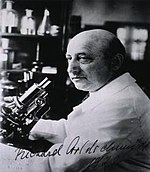
Back ريتشارد غولدشميت Arabic ريتشارد جولدشميت ARZ Richard Goldschmidt German Richard Goldschmidt Spanish Richard Goldschmidt French Richard Goldschmidt Galician Richard Goldschmidt ID Richard Goldschmidt Italian リチャード・ゴールドシュミット Japanese Richard Benedict Goldschmidt Polish
Richard Goldschmidt | |
|---|---|
 In his laboratory | |
| Born | April 12, 1878 Frankfurt am Main, Germany |
| Died | April 24, 1958 (aged 80) |
| Nationality | German |
| Alma mater | University of Heidelberg |
| Scientific career | |
| Fields | genetics |
| Doctoral advisor | Otto Bütschli |
Richard Benedict Goldschmidt (April 12, 1878 – April 24, 1958) was a German geneticist. He is considered the first to attempt to integrate genetics, development, and evolution.[1] He pioneered understanding of reaction norms, genetic assimilation, dynamical genetics, sex determination, and heterochrony.[2] Controversially, Goldschmidt advanced a model of macroevolution through macromutations popularly known as the "Hopeful Monster" hypothesis.[3]
Goldschmidt also described the nervous system of the nematode, a piece of work that influenced Sydney Brenner to study the "wiring diagram" of Caenorhabditis elegans,[4] winning Brenner and his colleagues the Nobel Prize in 2002.
- ^ Hall, B. K. (2001), "Commentary", American Zoologist, 41 (4): 1049–1051, doi:10.1668/0003-1569(2001)041[1049:C]2.0.CO;2
- ^ Dietrich, Michael R. (2003). Richard Goldschmidt: hopeful monsters and other 'heresies.' Nature Reviews Genetics 4 (Jan.): 68-74.
- ^ Gould, S. J. (1977). "The Return of Hopeful Monsters." Natural History 86 (June/July): 24, 30.
- ^ Rodney Cotterill Enchanted Looms: Conscious Networks in Brains and Computers 2000, p. 185
© MMXXIII Rich X Search. We shall prevail. All rights reserved. Rich X Search